
VNU Journal of Science: Natural Sciences and Technology, Vol. 40, No. 3 (2024) 1-12
1
Original Article
Characteristics and Methylene Blue Adsorption Capacity
of Pyrochar Derived from Lemongrass Residue
Truong Thi Thao1,*, Vuong Truong Xuan1,
Hoang Manh Hung2, Nguyen Ngoc An2, Nguyen Sy Duong2
1TNU-University of Sciences, Tan Thinh, Thai Nguyen City, Thai Nguyen, Vietnam
2Gang Thep High School, Trung Thanh, Thai Nguyen City, Thai Nguyen, Vietnam
Received 28th May 2024
Revised 20th August 2024; Accepted 21st August 2024
Abstract: In this study, the lemongrass essential oil distillation residue (LR) was the first
pyrolyzed under air-controlled conditions at 500 °C for 1 hour (B500), followed by activation
through alkali treatment under ultrasonic conditions at 70-80 °C for 3 hours (B5KOH). B5KOH
displayed a porous architecture with heightened surface area, 79.90 m2/g, twice the specific
surface of B500 material; and carbon content elevated to 87.99%. The material contained some
organic functional groups such as C=O, C=C, and C-O-C. The B5KOH sample exhibited the
most effective MB uptake at pH 8, achieving adsorption equilibrium within a brief timeframe
of approximately 30 – 50 minutes across a concentration spectrum of MB ranging from 5 to
500 mg/L at material loadings of 1-10 g/L, qm is 74.44 mg/g. The material demonstrated
substantial recyclability, maintaining nearly consistent adsorption efficiency through the fifth
cycle (decreasing marginally from 96.69% to 95.13%). Experimental adsorption conformed to
the Freundlich isotherm adsorption model and proceeds via a second-order kinetic model. The
adsorption phenomenon was spontaneous, primarily driven by physical interactions between
the B5KOH and MB molecules. Overall, lemongrass-derived pyrochar exhibited considerable
promise as an adsorbent material for mitigating MB pollution.
Keywords: Pyrochar, lemongrass, adsorption, methylene blue.
1. Introduction *
The latest statistics recently show that
approximately 106 tons of synthetic dyes are
produced annually [1]. Of which, a large part is
methylene blue (MB), a cationic dye, that is
_______
* Corresponding author.
E-mail address: thao.tt@tnu.edu.vn
https://doi.org/10.25073/2588-1140/vnunst.5271
widely utilized across textile, leather, paper,
pharmaceutical, food, and cosmetic industries
[2]. Nonetheless, up to about 25% of textile
dyes are lost during production and discharged
into the environment [3]. MB exhibits high
persistence, reduces the amount of dissolved
oxygen in water, and limits the ability of
aquatic organisms to adsorb light and
bioaccumulate through the food chain.
Ingestion of methylene blue-contaminated

T. T. Thao et al. / VNU Journal of Science: Natural Sciences and Technology, Vol. 40, No. 3 (2024) 1-12
2
water can precipitate adverse effects including
cyanosis, tissue necrosis, emesis, shock, and
heightened cardiac activity [2]. Research
demonstrates the inhibitory effects of MB on
growth, pigmentation, and protein levels in
algae species such as Chlorella Vulgaris and
Spirulina platensis [4], alongside teratogenic
impacts on murine and zebrafish models [5].
Notably, an ingestion of 5 mg/kg methylene
blue can impede monoamine oxidation, leading
to serotonin toxicity and potentially fatal
outcomes in humans [6]. Collectively, MB is
implicated in various complications affecting
digestive, respiratory, central nervous,
cardiovascular, reproductive, dermatological,
and other physiological systems [7].
Consequently, MB pollution represents a
substantial threat to both aquatic ecosystems
and human health.
The treatment and removal of residual MB
from water have been extensively researched
and implemented using various methods
including physical methods, chemical methods,
and biological methods. Among these,
adsorption is a physical method with numerous
advantages, including technical simplicity, and
high efficiency, which can be further enhanced
by selecting appropriate adsorbents [8].
Biochar, both pyrochar and hydrochar, derived
from agricultural and industrial by-products, is
currently a subject of intensive research,
utilizing inexpensive raw materials, and
reducing waste and CO2 emissions into the
environment. Moreover, biochar shares many
characteristics with activated carbon, showing
potential as an adsorbent material for treating
various types of pollutants, including both
organic and inorganic substances [9]. Hence,
numerous biomass types have been studied for
the production of biochar to treat various
pollutants, particularly for MB adsorption,
examples include globe artichoke leaves [10],
coconut shell [11], corncob [12], lychee seed
[13], seed of Cedrela odorata L [14], oil palm
empty fruit branch [15], mint-stalks [16], etc.
Lemongrass, extensively cultivated in
numerous tropical and subtropical regions,
serves diverse purposes, either directly utilized
in daily life or processed into essential oils [17],
thereby generating a notable volume of
lemongrass essential oil distillation by-products
(LR). Handling methods for this residue
commonly encompass combustion, burial, or
integration into soil matrices for agricultural
purposes. Despite some exploration into the use
of lemongrass biochar for soil enhancement
[18], investigations into its production as an
adsorbent material remain scant [19],
particularly concerning its potential for MB
adsorption. The distillation process is already a
pre-treatment step, making the LR clean,
fibrous, and porous, very convenient for
biochar production, time, and temperature
pyrolysis will be lower than other biomass. It is
also convenient and suitable for large-scale
production if needed.
Given the predominant presence of
cellulose in lemongrass, as evidenced by
chemical structure analyses [20], in this study,
we undertook the pyrochar from lemongrass
essential oil distillation residue (LR) with
incorporated alkali activation, scrutinizing its
structural attributes, and assessing its efficacy
in MB adsorption from aqueous solutions.
2. Experimental
2.1. Equipment and Chemicals
Chemicals (analytical grade purity):
Potassium hydroxide (KOH), methylene blue
(MB, C16H18ClN3S), sodium hydroxide (NaOH),
hydrochloric acid (HCl), distilled water, 96°
ethanol, LR obtained from the essential oil
distillation workshop of the Institute of Life
Sciences at Thai Nguyen University of
Agriculture and Forestry. The equipment used for
the preparation of biochar is a 100 mL
hydrothermal reactor (TOB Reactor, China).
2.2. Synthesis and Material Characteristics
Material Synthesis:
The process involved preparing the LR by
drying and finely grinding it before placing it
into a covered porcelain crucible and wrapping

T. T. Thao et al. / VNU Journal of Science: Natural Sciences and Technology, Vol. 40, No. 3 (2024) 1-12
3
it in aluminum foil. Subsequently, it underwent
pyrolysis at 500 °C for 1 hour. Afterward, it was
allowed to naturally cool to room temperature and
finely ground to produce B500 material. A portion
of B500 was dispersed in a 5M KOH solution in
an ultrasonic bath at 70-80 °C for 3 hours.
Following this, it was thoroughly washed with
distilled water until reaching a neutral pH,
dried, and finely ground again to yield B5KOH
material. Storage of the materials was carried
out in sealed plastic bags within a desiccator
when not in use.
Material Characterization:
The bonding characteristics and functional
groups of the materials underwent analysis
using an IR Spectrum Two spectrometer by
Perkin Elmer (USA) within the wavenumber
range of 4000 – 400 cm⁻¹ at the Laboratory
Center of the University of Science, Thai
Nguyen University. Elemental composition
analysis was conducted via energy-dispersive
X-ray spectroscopy (EDS) on a Jeol 6490 –
JED 2300, while material morphology
examination was performed using scanning
electron microscopy (SEM) on a Hitachi
S-4800 (Japan) at the Institute of Materials
Science, Vietnam Academy of Science and
Technology. Determination of the porous
structure and specific surface area was achieved
using the Brunauer-Emmett-Teller (BET)
method on a TriStar 3000 V6.07 at the Faculty
of Chemistry, Hanoi National University of
Education. The point of zero charge was
experimentally determined using the pH drift
method with a NaCl solution: Prepare 0.1 M
NaCl solutions with an initial pH ranging from
2.0 to 11.0 (adjusted using 0.1 M HCl or 0.1 M
NaOH solution); add to each 10 mL of NaCl
solution 0,01 g of B5KOH, mix until completely
dispersed; after 48 hours, the final pH was
measured, and the zero point of charge was
determined from the plot of ΔpH versus initial
pH, where ΔpH = final pH - initial pH = 0.
2.3. Adsorption Experiment
MB was investigated for their adsorption
behavior using B500 and B5KOH samples at
different pH for 3 hours. Notably, B5KOH
demonstrated a significantly higher adsorption
capacity for MB. Subsequent investigations
aimed to assess the adsorption of MB onto
B5KOH across a range of concentrations from
5 to 500 mg/L, utilizing B5KOH dose varying
from 1.0 g/L to 10.0 g/L time intervals spanning
5 to 900 minutes at both 25 °C and 40 °C.
Each experimental trial involved the
preparation of an MB solution with a specific
concentration, precise pH adjustment,
aliquoting 10 mL into a 15 mL Falcol tube,
addition of a predetermined amount of B5KOH,
agitation of the mixture for the specified
duration, centrifugation at 5000 rpm for 15
minutes, filtration and extraction of the
solution, and determined the concentration of
the MB before and after adsorption using
UV-Vis spectroscopy at wavelengths of 664,
with standard curves established within the
concentration range of 0.1 to 20 mg/L. Control
samples underwent identical treatment
procedures but lacked MB addition. Each
experiment was replicated three times to obtain
the mean value.
The MB adsorption efficiency (AE, %) and
the adsorption capacity (qt, mg/g) of the material
are calculated using the following formulas:
AE = (%) (1)
qt = (mg/g) (2)
Where: Co and Ct are the concentrations of
MB in the solution before and after the
adsorption time t (minutes); m is the mass of
the adsorbent material (g); V is the volume of
the working solution (L).
Material reusability:
The material, after adsorbing MB, is
collected, washed with alcohol and distilled
water, and then immersed in 1 M HCl,
changing the solvent every 3-5 hours. After
24 hours, it is rinsed again with absolute
alcohol three times, then washed with distilled
water until neutral [21]. Finally, it is dried at
70 - 80 °C for reuse.

T. T. Thao et al. / VNU Journal of Science: Natural Sciences and Technology, Vol. 40, No. 3 (2024) 1-12
4
3. Results and Discussion
3.1. Material Characteristics
Figure 1a shows the EDS patterns of LR
and pyrochar samples, the elemental
composition of samples is shown in Table 1.
LR contains high carbon content, 62.12%,
making it is a potential feedstock to
produce carbon-rich biochar. After pyrolysis,
the carbon content in the B500 sample
increased to 82.33%. This is due to the effect of
heat during calcination, which broke the C–O
bond, leading to the release of oxygen-
containing compounds from LR and enhancing
the carbonization process. The carbon content
of the B5KOH sample further increased to
87.99% following KOH activation. This
increase is due to KOH and ultrasonic vibration
at 80-90 oC, which continued to oxidize B500,
releasing oxygen-containing gases, or dissolved
salts, encouraging pore formation. It also
removed tar and other impurities in the
pyrochar, such as SiO2. As a result, the oxygen
content continued to decrease, the carbon
content continued to increase and the pore size
also increased. This change was confirmed by
the BET analysis results. This elevated carbon
content surpasses that reported in comparable
biochar studies involving materials such as rice
straw [22] and corn stalk [23]. Furthermore,
trace amounts of elements including K, Na, Ca,
Cl, Si, etc., persist in the samples, constituting
mineral components naturally present in
the original LR's chemical composition,
occurring in both inorganic and organometallic
forms, thereby augmenting the material's
polar properties.
F
Figure 1. EDS spectrum (a), IR spectrum (b)SEM images of LR (c), B500 (d), and B5KOH (e) samples.

T. T. Thao et al. / VNU Journal of Science: Natural Sciences and Technology, Vol. 40, No. 3 (2024) 1-12
5
Table 1. Elemental composition and Pore parameters of LR and pyrochar samples
sample
Elements (%)
Pore parameters
C
O
Si
P
K
Ca
BET
(m2/g)
VPore
(cm3/g)
dPore
(nm)
LR
62.12
36.79
0.09
0.10
0.32
0.07
-
-
-
B500
82.44
15.10
0.20
0.20
0.24
0.41
32.66
0.010127
8.5
B5KOH
87.99
10.87
0.16
0.22
0.23
0.31
79.90
0.036393
19.8
F
Figure 1b shows that, upon the pyrolysis of
LR, marked alterations in the sample's bonding
structure were observed: i) Broad peaks in the
3400 cm-1 region, indicative of the stretching
vibration of hydrogen-bonded hydroxyl groups
(derived from carboxylic, phenolic, or alcoholic
moieties) or adsorbed water molecules in the
residue, reduced intensity and expanded;
ii) Characteristic peaks corresponding to
aliphatic C-H stretching (from aromatic
methoxy groups, methyl, and methylene groups
of side chains) and aromatic C-H stretching at
wavenumbers of 2922 and 2844 cm-1,
respectively, were scarcely discernible in the
biochar; iii) Peaks at 1737 and 1640 cm-1 in the
LR shifted to 1696 and 1582 cm-1, respectively,
indicative of C=O bonds in carbonyl or
carboxyl groups (representing C=O stretching
vibrations of ketones, aldehydes, lactones, or
carboxyl groups, and C=C vibrations in
aromatic rings) [24]; iv) the characteristic peak
at 1034 cm-1 corresponding to C-O-C bonds
also shifted to 1104 cm-1; and v) peak in the
region of 2190 cm-1 to 2330 cm-1, characteristic
of C≡C bonds in the LR [25], exhibited
significant reduction in sample B500 and were
absent in sample B5KOH. Furthermore, distinct
peaks at 470 and 617 cm-1 emerged in the
pyrolyzed samples, typically associated with
metal-oxygen bonds, potentially enhancing the
adsorption process.
The SEM image of the LR powder (Figure
1c) shows that the LR surface is monolithic,
with a peeling phenomenon and many thin,
small scales. This is the result of the essential
oil distillation process. After calcinating at 500 °C
for 1 hour, the original structure of LR 1d) was
disrupted, leading to the creation of voids
(Figure 1d).
Figure 2. a) BET diagram and b) Isoelectric point of
the B5KOH material
Some of these voids undergo fragmentation,
resulting in the formation of small, porous
fragments. When the B500 sample is treated






![Câu hỏi ôn tập Vi sinh môi trường [năm hiện tại]](https://cdn.tailieu.vn/images/document/thumbnail/2025/20250710/kimphuong1001/135x160/8671752134731.jpg)
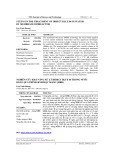
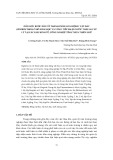
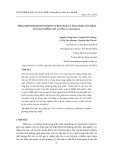
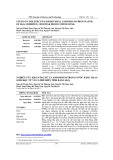

![Tài liệu Vi sinh vật môi trường [Mới nhất]](https://cdn.tailieu.vn/images/document/thumbnail/2025/20251123/ngkimxuyen/135x160/21891763953413.jpg)
![Sổ tay truyền thông Phân loại chất thải rắn sinh hoạt trên địa bàn tỉnh Quảng Nam [Chuẩn nhất]](https://cdn.tailieu.vn/images/document/thumbnail/2025/20251114/kimphuong1001/135x160/1701763094001.jpg)

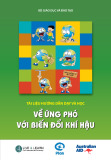
![Quản lý chất thải nguy hại: Sổ tay Môi trường [Chuẩn nhất]](https://cdn.tailieu.vn/images/document/thumbnail/2025/20251029/kimphuong1001/135x160/9011761720170.jpg)









